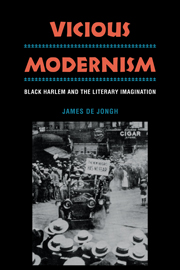Book contents
- Frontmatter
- Contents
- Acknowledgments
- Introduction: Vicious Modernism
- I The Legendary Capital: The 1920s and 1930s
- II The Emerging Ghetto: The 1940s and 1950s
- III The Inner City: The 1960s and 1970s
- 9 The Inner City
- 10 Jitterbugging in the Streets
- 11 Echoes in a Burnt Building
- 12 Mumbo Jumbo
- Epilogue: Black Harlem and the Literary Imagination
- Appendix 1 A Checklist of Black Harlem in Poetry
- Appendix 2 A Checklist of Black Harlem in Novels
- Notes
- Index
- Frontmatter
- Contents
- Acknowledgments
- Introduction: Vicious Modernism
- I The Legendary Capital: The 1920s and 1930s
- II The Emerging Ghetto: The 1940s and 1950s
- III The Inner City: The 1960s and 1970s
- 9 The Inner City
- 10 Jitterbugging in the Streets
- 11 Echoes in a Burnt Building
- 12 Mumbo Jumbo
- Epilogue: Black Harlem and the Literary Imagination
- Appendix 1 A Checklist of Black Harlem in Poetry
- Appendix 2 A Checklist of Black Harlem in Novels
- Notes
- Index
Summary
In the 1950s and early 1960s, the Harlem ghetto was plumbing the nadir of its decline. “Harlem was getting fucked over by everybody, the politicans, the police, the businessmen, everybody,” Claude Brown wrote in his autobiography, Manchild in the Promised Land (p. 198). The dream seemed permanently deferred. Most of the celebrated figures who had made the Harlem legend either were no longer alive or no longer lived in Harlem. The residual energy and optimism of the legendary spirit of Harlem had been exhausted. Harlem had lost its nighttime cachet. A few survivors of Harlem's once-glamorous cabaret life, such as Small's Paradise, where Malcolm Little had spent several years as “Harlem Red,” lingered on, in reduced circumstances. People were still stomping at the Savoy, but the most talented musicians were playing in the jazz spots of West Fifty-Second Street and Greenwich Village, rather than in Harlem, and the Cotton Club had long since moved downtown to Broadway and Forty-Eighth Street. Only the Apollo Theatre, supported by a faithful black clientele, was flourishing. From 1941 to the mid-1950s, the relative position of black workers, compared with that of white workers, improved generally, and economic progress kept pace with the expectations of the black masses, but after the recession of 1954–5, living conditions declined steadily for the majority of Harlemites, who lacked the resources to escape the ghetto by moving to integrated neighborhoods or the new black neighborhoods of choice, or who simply did not wish to abandon the place they had made their home.
- Type
- Chapter
- Information
- Vicious ModernismBlack Harlem and the Literary Imagination, pp. 137 - 145Publisher: Cambridge University PressPrint publication year: 1990



